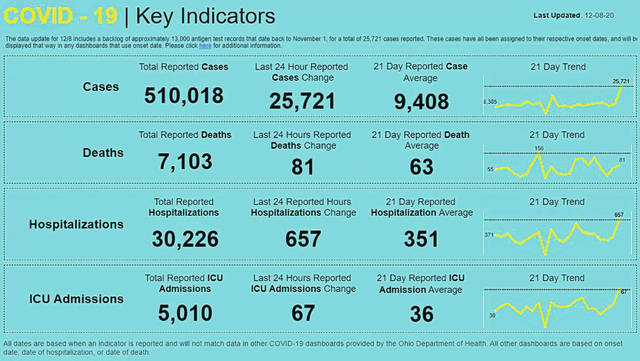
COLUMBUS – The Ohio Department of Health (ODH) Tuesday reported the Bureau of Infectious Disease has cleared the backlog of pending files that dated back to Nov. 1 — causing a one-day spike in cases, bringing Tuesday’s reported case total to 25,721.
Included in the reported cases for Tuesday are the results from approximately 13,000 that were part of the report backlog. The onset date for these cases have been backfilled and appropriately recorded. The note about pending files has been removed from the website.
“After understanding more about antigen tests, the Centers for Disease Control and Prevention (CDC), changed their case definition in August allowing antigen tests to be included in case counts without additional verification,” said ODH Chief Medical Officer Dr. Bruce Vanderhoff. “ODH is now aligned with CDC’s current definition and we will begin reflecting those tests immediately in our daily reported case counts moving forward.”
At the beginning of the pandemic, only PCR tests were available for the diagnosis of COVID-19. As antigen tests were developed in the spring, the CDC issued guidance that allowed for a positive antigen test to be counted as a probable case only if additional criteria were met. The additional criteria included either an epidemiological link to a known case of COVID-19, or symptoms of COVID-19.
More information on the overall numbers can be found on the coronavirus.ohio.gov website.
Curfew continues
Gov. Mike DeWine announced Monday that he will extend the statewide curfew as Ohio surpassed 7,000 virus-related deaths.
“We think the curfew, as well as the mask order and the enforcement, have slowed this rate of increase, but it is still at too high of a level,” DeWine said during a virus briefing.
One in every 193 people in Ohio tested positive for the virus in the past week (through Monday).
The statewide curfew of 10 p.m. to 5 a.m., designated Nov. 17, is set to expire Thursday, but DeWine said it would have to be extended as health experts believe it is helping to marginally flatten the curve in Ohio. The measure would require businesses to be closed by 10 p.m.
It exempts pharmacies and groceries and restaurants offering takeout or delivery service. Previously, DeWine had ordered restaurants and bars to stop serving alcohol at 10 p.m. The new order requires those businesses to close all dine-in and walk-in service by 10 p.m.
The order doesn’t apply to people who need to be at work, who have an emergency or need medical care, DeWine said.


